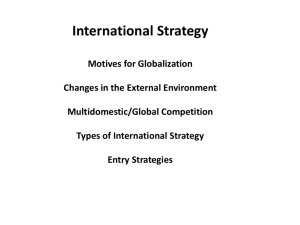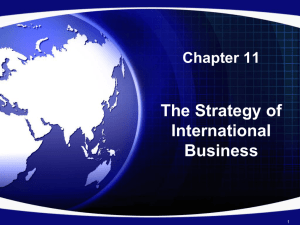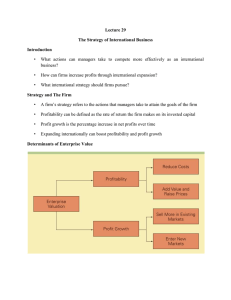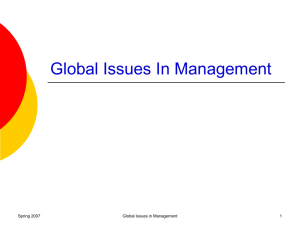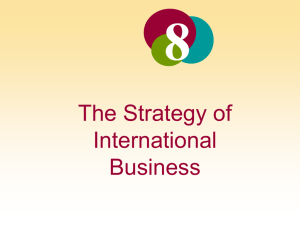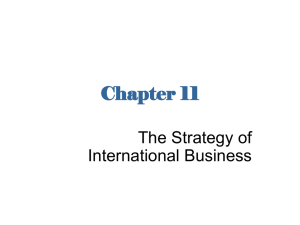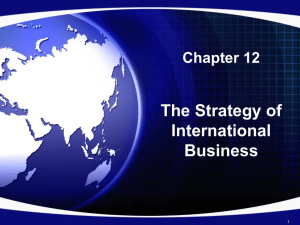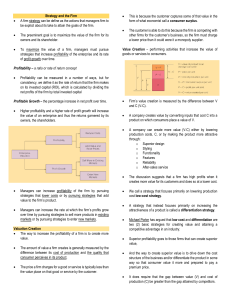The Strategy of International Business
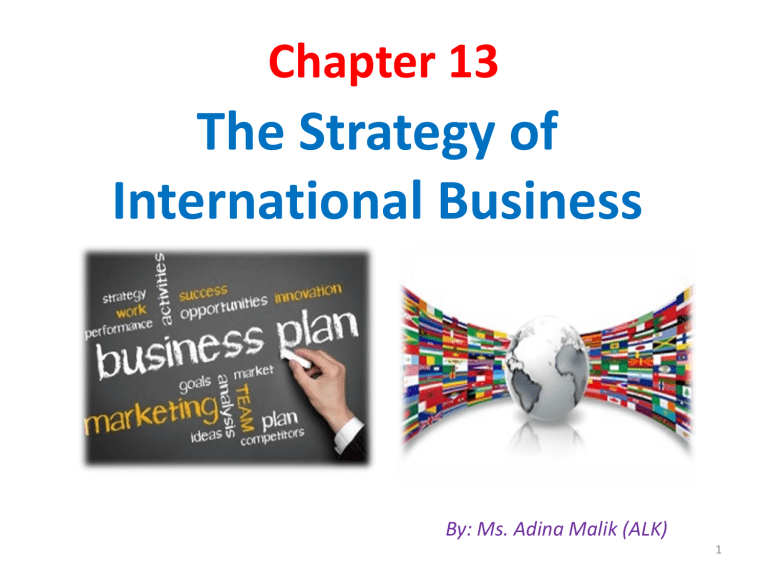
Chapter 13
The Strategy of
International Business
By: Ms. Adina Malik (ALK)
1
Learning Objectives
• Explain the concept of strategy
• Understand how firms can profit by expanding globally
• Understand how pressures for cost reductions and local responsiveness influence strategic choices
• Be familiar with different strategies for competing globally and their pros and cons
2
What is Strategy?
• A firm’s strategy refers to the actions that managers take to attain the goals of the firm
• Firms need to pursue strategies that increase profitability and profit growth
– Profitability is the rate of return the firm makes on its invested capital
– Profit growth is the percentage increase in net profits over time
• To increase profitability and profit growth , firms can
– add value
– lower costs
– sell more in existing markets
– expand internationally
3
How is value created?
• The firm’s value creation is the difference between V (the price that the firm can charge for that product given competitive pressures/value of a product to an average customer) and C (the costs of producing that product)
4
How is value created?
Profits can be increased by:
1. Using a differentiation strategy - adding value to a product so that customers are willing to pay more for it
– the higher the value customers place on a firm’s products, the higher the price the firm can charge for those products
2. Using a low cost strategy - lowering costs
5
How is value created?
• A company can create more value (V-C) either by lowering the production costs, C, or by making the product more attractive so that customers place a greater value on it (V increases).
• Michael Porter has argued that low cost and differentiation are two basic strategies for creating value and attaining competitive advantage in an industry.
• Superior value creation implies that the gap between V-C should be greater than the gap competitors attain. It does not necessarily mean that firms need to have the lowest cost structure or most valuable product in the industry.
6
The Value Chain
7
How Are A Firm’s Operations
Configured?
• A firm’s operations can be thought of a value chain composed of a series of distinct value creation activities including production, marketing, materials management,
R&D, human resources, information systems, and the firm infrastructure
Value creation activities can be categorized as
1. Primary activities
– R&D, production, marketing and sales, customer service
2. Support activities
– information systems, logistics, human resources
8
How Can Firms Increase Profits Through
International Expansion?
International firms can:
1. Expand their market - sell in international markets
2. Realize location economies - disperse value creation activities to locations where they can be performed most efficiently and effectively
3. Realize greater cost economies from experience effects serve an expanded global market from a central location
4. Earn a greater return - leverage skills developed in foreign operations and transfer them elsewhere in the firm
9
Increasing Profits By Expanding the
Market
• Firms can increase growth by selling goods or services developed at home internationally
• The success of firms that expand internationally depends on
– the goods or services they sell
– their core competencies - skills within the firm that competitors cannot easily match or imitate
– core competencies enable the firm to reduce the costs of value creation and/or to create perceived value so that premium pricing is possible
• E.g.: Procter & Gamble, Microsoft, McDonalds, Toyota
10
Why Are Location Economies
Important?
• Location economies are the economies that arise from performing a value creation activity in the optimal location for that activity, wherever in the world that might be
• By achieving location economies, firms can
– lower the costs of value creation and achieve a low cost position
– differentiate their product offering
• Firms that take advantage of location economies in different parts of the world, create a global web of value creation activities
– different stages of the value chain are dispersed to locations where perceived value is maximized or where the costs of value creation are minimized
11
Why Are Location Economies
Important?
• Example of Global Web: Lenovo’s ThinkPad laptop computers
• The product is designed in the US (basic design work)
• The case, keyboard and hard drive are made in Thailand
• Display screen and memory are made in South Korea
• Built-in wireless card from Malaysia
• Microprocessor from the US
• Assemble operation in Mexico
• Final sale in the US
12
Why Are Experience Effects
Important?
• The experience curve refers to the systematic reductions in production costs that occur over the life of a product.
• By moving down the experience curve, firms reduce the cost of creating value and it is also strategically significant for companies to gain competitive advantage.
• Two things explain this relationship: 1) Learning Effects and 2)
Economies of Scale.
13
Why Are Experience Effects
Important?
• Learning effects are cost savings that come from learning by doing
• When labor productivity increases
– individuals learn the most efficient ways to perform particular tasks
– managers learn how to manage the new operation more efficiently
• Economies of scale refer to the reductions in unit cost achieved by producing a large volume of a product
• Sources of economies of scale include
– spreading fixed costs over a large volume
– utilizing production facilities more intensively
14
How Can Managers
Leverage Subsidiary Skills?
• Managers should
1. Recognize that valuable skills that lead to competencies can arise anywhere within the firm’s global network - not just at the corporate center
2. Establish an incentive system that encourages local employees to acquire new skills
3. Have a process for identifying when valuable new skills have been created in a subsidiary
4. Act as facilitators to help transfer skills within the firm
15
How Can Managers
Leverage Subsidiary Skills?
• Example: McDonalds In France for example, slow sales recently prompted a shift toward a more inviting atmosphere with an upgraded menu.
• The company is currently considering using this format at other locations where sales are sluggish.
16
What Types Of Competitive Pressures Exist In
The Global Marketplace?
• Firms that compete in the global marketplace face two conflicting types of competitive pressures
1. Pressures for cost reductions - force the firm to lower unit costs
2. Pressures to be locally responsive - require the firm to adapt its product to meet local demands in each market— a strategy that raises costs
The pressures limit the ability of firms to realize location economies and experience effects, leverage products, and transfer skills within the firm.
17
What Types Of Competitive Pressures Exist
In The Global Marketplace?
18
When Are Pressures For Cost Reductions
Greatest?
• Pressures for cost reductions are greatest
1. In industries producing commodity type products that fill universal needs (needs that exist when the tastes and preferences of consumers in different nations are similar if not identical) where price is the main competitive weapon.
– E.g. steel, sugar, bulk chemicals, petroleum, etc.
2. When major competitors are based in low cost locations, where there is persistent excess capacity and where consumers are powerful & face low switching costs.
19
When Are Pressures For Local
Responsiveness Greatest?
• Pressures for local responsiveness arise from:
1.
Differences in consumer tastes and preferences
North American consumers have a strong demand for pick-up cars, whereas such cars are seen as utility vehicles by the Europeans.
When selling cell phones to the US consumers, manufacturers focused more on slim good looks and less on advanced functions and features.
But, consumers in Asia and Europe preferred text messaging and web browsing features.
2.
Differences in traditional practices and infrastructure
In North America, consumer electrical systems are based on 110 volts, while in European countries 240-volt systems are standard.
20
When Are Pressures For Local
Responsiveness Greatest?
3. Differences in distribution channels
– The differences in distribution channels require that countries adapt their own distribution and marketing strategy.
– In Brazil supermarkets account for 36% of food retailing, in Poland is 18%, and in Russia less than 1%.
4. Host government demands
– Economic and political demands imposed by host country governments may require local responsiveness
– For example, pharmaceutical companies are subject to local clinical testing, registration procedures and pricing restrictions which vary from countries to countries. All these make it necessary that manufacturing and marketing of a drug meet local requirements.
21
Which Strategy Should A Firm
Choose?
• There are four basic strategies to compete in international markets
– the appropriateness of each strategy depends on the pressures for cost reduction and local responsiveness in the industry
1. Global standardization - increase profitability and profit growth by reaping the cost reductions from economies of scale, learning effects, and location economies
– Goal is to pursue a low-cost strategy on a global scale
– It makes sense when there are strong pressures for cost reductions and demands for local responsiveness are minimal
– Firms prefer to market standardized products or products which serve universal needs. This strategy is appropriate for industrial goods , not consumer goods.
22
Which Strategy Should A Firm
Choose?
2. Localization - increase profitability by customizing goods or services so that they match tastes and preferences in different national markets
– It makes sense when there are substantial differences across nations with regard to consumer tastes and preferences and when cost pressures are not too intense
– E.g. US (pick-up trucks); Europe & Japan (small fuel efficient cars)
3.International
– take products first produced for the domestic market and sell them internationally with only minimal local customization
– It makes sense when there are low cost pressures and low pressures for local responsiveness
– E.g.: Xerox, Procter & Gamble, Microsoft
23
Which Strategy Should A Firm
Choose?
4.
Transnational - tries to simultaneously achieve low costs through location economies, economies of scale, and learning effects, differentiate the product offering across geographic markets to account for local differences, and foster a multidirectional flow of skills between different subsidiaries in the firm’s global network of operations
– It makes sense when cost pressures are intense and pressures for local responsiveness are intense.
– This strategy is not easy to pursue as it places conflicting demands on the company.
– E.g.: Ford found it difficult to implement.
– E.g. Caterpillar started to pursue this strategy in 1979 and by 1990s had succeeded in doubling output per employee, significantly reducing its overall cost structure in the process.
24
Which Strategy Should A Firm
Choose?
25
How Does Strategy Evolve?
• An international strategy may not be viable in the long term
– to survive, firms may need to shift to a global standardization strategy or a transnational strategy in advance of competitors
• Localization may give a firm a competitive edge, but if the firm is simultaneously facing aggressive competitors, the company will also have to reduce its cost structures
– would require a shift toward a transnational strategy
26
How Does Strategy Evolve?
27


